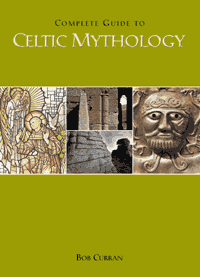 |


|
|||
 GOIBHNiU Goibhniu or the Gobán Saor is the ancient Celtic god of smithcraft, sometimes also portrayed as an architect. The word ‘saor’ added to his name denotes an 'artificer’ or ‘artisan’ endowing Goibhniu with wider functions than those of smith-god or metalworker. it seems that the irish Goibhniu and his Welsh counterparts Gofannon and Gwydion were regarded as expert craftsmen and designers and much sought after, both by gods and mortals, for the excellence of their work. in Celtic Christian mythology, the Gobán Saor is credited with the design and construction of many early churches. Taking the analogy further it might be that, in some parts of the Celtic world, Goibhniu was loosely equated with God as the Master Builder of the Firmament and the Designer of Creation. He appears as such in a ninth-century poem where he is described as Gobán. Although primarily a builder, Goibhniu was credited with power over natural forces. By throwing his axe and creating a line in the sand, he ensured that the incoming tide advanced no further than Tráigh Thuirbhe – Turvey Strand near Lusk in County Dublin. in some versions of the tale, Goibhnui is identified as one of the sons of the chieftain Tuirbhe who gave his name to the Strand. Later adaptations relate Tuirbhe to Lúgh, the Celtic god of light, giving Goibhniu his divine pedigree in the overall Celtic pantheon. Since the advent of Christianity, Gobán became an accepted personal name and was even adopted by several saints - perhaps to show a connection with early medieval architecture or to denote their prowess as artisans. it is also used to show the superiority of the church. in the Life of Saint Albán, we learn that a distinguished wight named Gobán lived near where the saint had his cell and that he frequently did work for a neighbouring monastery. The price he charged the monks for his services was too high and they cursed him, leaving him blind. Albán restored the wight's sight and Gobán became one of his most devoted followers, building a church dedicated to him that contained wondrous carvings not seen anywhere else in the world. Gobán also appears in a tale concerning another holy man, Saint Molaing. The saint, says the legend, had a wonderful oratory constructed for him from timber by a workman called Gobán Saor. As payment, Gobán's wife demanded that the oratory should be filled with grain that would then be given to Gobán. The wily saint agreed, provided the wight could invert the oratory so that it might be filled. He stipulated that if it were damaged in any way through this manoeuvre, Gobán would receive no payment at all. in doing so, Saint Molaing thought he would trick Gobán out of the entire payment. The workman was so skilful that no damage was done to the oratory, and the saint had to pay him. The notion of the holy or godly workman seemed to have begun in ireland in the south Leinster area, probably associated with a local pagan artisan-cult. it rapidly spread to other parts of ireland, perhaps owing something to the spread of Christianity. in the 10th century Gobán was described as ‘the greatest smith/builder that ever lived’ and a number of ancient monasteries, churches and round towers were ascribed to his handiwork. By then, the tension between the pagan gods and the Christian ideal seemed to have disappeared – several of the former deities were accepted into the Church as holy figures. One curious tale about Gobán survives. it was said that his fame as an architect/builder reached as far as south Munster where a number of monks hired him, although he was a pagan, to build a new tower for their abbey. Gobán built the tower for them but the monks refused to pay him the rate that they had agreed, offering him a far lower wage. He refused to renegotiate the contract and while he was working at the top of the tower, the monks removed all his ladders, leaving him stranded. They would put the ladders back, they said, only if Gobán would agree to their terms. The wily builder began to drop the stones of the tower itself to the ground, one on top of the other, saying that this was as easy a way as any to come down. The monks, seeing their beautiful tower literally vanishing before their eyes, were forced to relent and pay Gobán his full wages. The story is particularly curious because it demonstrates the triumphant guile of the pagan over the officers of the Church. See also: Spirits of Earth and Air
From Complete Guide to Celtic Mythology by Bob Curran |
[ Back to top ]
All Material © 1999-2009 irelandseye.com and contributors

